Early Saturday morning, November 7, 2020 – “Biden Wins!” After days of agony waiting for final ballots to be counted, the race for the President of the United States is called, by one network, then another, then another, then all of them. Cheering and people rejoicing in New York City could be heard through open windows, as people breathed a sigh of collective relief. The thunderstorm is over; a ray of sunlight broke through. And a rainbow marks the beginning of better days ahead, as we rebuild kindness and decency towards every fellow human.
Tom Denford jokingly suggested in a tweet “Super excited to learn “5 things marketers can take from Biden’s victory” on Monday morning. I could not wait till Monday, so I wrote it today. Indeed marketers could learn some things from Biden’s victory, perhaps 5, perhaps more. Here are the five that come to my mind, having been in and observed marketing for 25 years. What follows is not political commentary, but commentary on marketing.
Slow, wins.
Everyone knows Aesop’s fable of the tortoise and the hare. And “slow and steady wins the race” is a phrase repeated regularly. This is particularly true for marketing, but sadly it has been particularly forgotten in the headlong rush into digital. Too many marketers try to buy success by showing more ads to more people more often. They push their agencies to buy ever more vast quantities of digital ads, at ever lower unit prices. This has led to a prolonged deterioration of actual business outcomes and marketing efficacy, a veritable “lost decade” of digital marketing.
The headlong plunge into digital and the unchecked spending in programmatic channels led to dramatic increases in the number of ads purchased, and a concomitant increase in ad fraud. The number of humans on earth didn’t suddenly multiply many times over; and their time spent online, on social, and on mobile didn’t multiply many times over either. But the number of digital ads did multiply, reaching into unfathomable territory – half a quadrillion ads per year. The vast majority of these ads were created out of thin air by bots, not by humans visiting sites, using social media, or using mobile apps. So while marketers are spending $350 billion every year on digital ads, their business outcomes don’t reflect the spending. And the marketing efficacy is lower and lower due to more and more fraudulent activity.
You can’t buy your way to “wins” quickly. Slow and steady does indeed win out, long term.
Right, wins.
When marketers are spending so many billions of dollars in digital, someone’s going to ask if it’s worth it. So the marketers that are doing the most spending (ahem, CPG companies with too much money to spend) look for ways to justify it. The metrics they and their media agencies conveniently chose were quantity metrics like number of ad impressions purchased, the average unit price, and the number of clicks, traffic to their sites, and click through rates. But just because these metrics were easy to measure doesn’t mean they were the right metrics to use to prove marketing value.
In fact, these vanity metrics, oops “quantity metrics,” were easy to think about, because more meant better. But if the marketer didn’t know about bots and fraud, they wouldn’t know that these are also the easiest metrics for bots to fake. Bots can generate more ad impressions, and drive higher click through rates, and create more traffic to advertisers’ websites all to make the campaigns appear to be performing better than they really are. Despite drastic increases in these quantity metrics, business outcomes remained flat to down. Some business outcomes may have gone up, but the rise was entirely unrelated to digital marketing activities (more people wanted to buy toilet paper for some reason, not because of advertising). And remember when P&G cut $200 million from digital ad spending and saw no change in business outcomes?
Having the right metrics in place, and using them, means you know when you are driving real outcomes, rather than just getting “more of” various vanity metrics.
Detailed, wins.
With the right metrics and analytics in place, it “pays” to be detailed oriented and actually check the details yourself. Too often, these duties are passed off to agency partners. While some agency partners have the right-skilled analytics folks to look at the data for you, most don’t have the desire to do more work than they are paid for. Sadly, if the client (the advertiser) appears to be happy with campaign performance and doesn’t ask for more details, why make the effort and show them analytics? So advertisers must look more closely at analytics for their own campaigns.
With detailed data, they can see if campaigns are actually performing — not the clicks and traffic stuff — but actually driving incremental business outcomes. If the campaigns are not, and if there is ad fraud observed, marketers can make tweaks themselves to optimize the campaigns while they are still running. It’s much like making small course corrections with tiny movements of the steering wheel when driving down the highway. You don’t make large turns. Having detailed analytics enables you to see whether there is any fraud impacting your campaigns — common send and your gut will tell you something needs to be further investigated. And it will tell you what is working or not working so you can make the small course corrections as you go.
Detail-oriented wins out over handing off your analytics and duties to someone else.
Good, wins.
While fraudsters “clean up well” and are the slickest of the slick salesmen, ad tech companies can only dupe clients into paying for their snake oil for so long. Sooner or later, when advertisers start looking at the right data in more detail, like we said above, they will realize the snake oil didn’t “cure the cancer” as it claimed. In fact, it WAS the cancer that was draining ad budgets — directly into the fraudsters’ pockets (as opposed to showing ads or doing better digital marketing). The fraudsters make a quick buck, sometimes gobs and gobs of it, “by hook or by crook.” They can fool enough advertisers enough of the time to take money off of them. And even when the are outed, they just change the name of the company or start another company and go back to doing what they do best. Yes, this has happened, A LOT, in ad tech. And we’re not even talking about the cases where fraud detection companies shake down clients and prospects — if you don’t pay us, we’ll lower your score, mark you as fraudulent, or remove you from lists.
In the long run, extortion, crime, and even petty theft, are not sustainable ways to do business. Doing good, and doing good business, are good for the long run, not to mention you sleep better at nights, not having to worry when you will be found out. Good, doing the right thing, is often harder and definitely takes more time and effort than stealing a quick buck. But good wins.
Trust, wins.
One you get good at doing good business for your clients, you also do good business for your business. You earn trust over time; you build real bridges with your clients, so they stick with you through good times and bad. They trust you to be stewards of their ad budgets, and to invest it wisely in marketing activities that drive real business outcomes for them, not vanity metrics reported on monthly spreadsheets.
Trust wins in the long term; and this brings us full circle to the first point – slow, wins. Trust is slow to build, but can be lost in an instant. If you invest in trust with your clients and partners, the pay off is over time; it’s not a lump sum pay-out, like one of the choices on a lottery ticket. Trust wins, and slow wins more. Earn it over time by building real relationships, even if short term metrics, and profits, are not as high.
Together, Everyone wins.
And finally, today, Democracy wins and decency wins. Hope and faith have hope again. Onward and upward for the United States of America, and for all citizens of humankind.
Van Jones Twitter Screen shot
Feature Image Credit: STRF/STAR MAX/IPx
By Dr. Augustine Fou
Follow me on Twitter or LinkedIn. Check out my website.
I am a digital marketer of 25 years. Now I help marketers audit their digital campaigns for ad fraud that isn’t caught by widely used ad verification services.
I have witnessed the entire arc of the evolution of digital marketing, since the mid-90’s. I taught classes in digital strategy at NYU’s School of Continuing and Professional Studies and Rutgers University’s Center for Management Development.
I have worked on the “client side” for American Express, and on the “agency side” as Group Chief Digital Officer of Omnicom’s Healthcare Consultancy Group and SVP Digital Strategy Lead at McCann Worldgroup/MRM Worldwide. I started my career in New York City with McKinsey & Company.







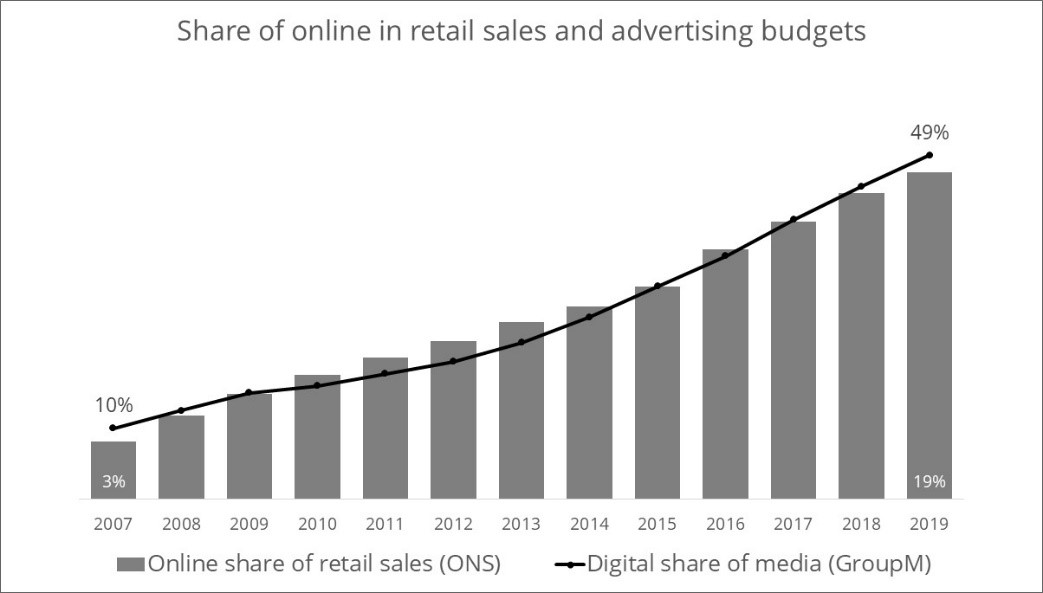 Ah, but correlation is not causation, a sceptic might argue. The chart fits other explanations too. For example, both ecommerce and online advertising rely on the same technologies, so of course they grow together. Or perhaps ecommerce and online advertising are both superior to their offline versions and people have simply begun to use them both more over time.
Ah, but correlation is not causation, a sceptic might argue. The chart fits other explanations too. For example, both ecommerce and online advertising rely on the same technologies, so of course they grow together. Or perhaps ecommerce and online advertising are both superior to their offline versions and people have simply begun to use them both more over time.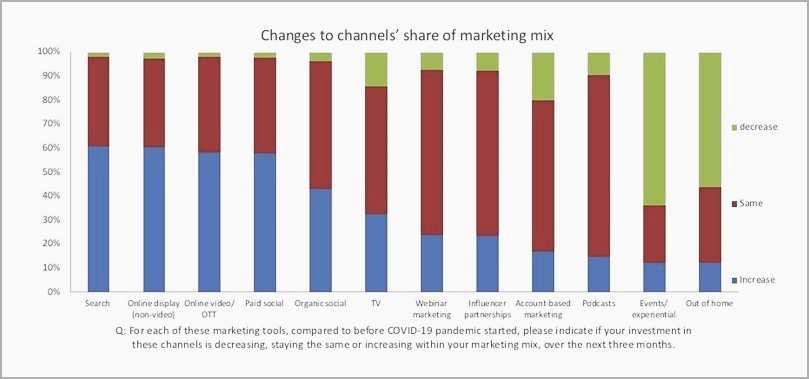 Some of this change in the media mix is driven by lockdowns and reduced available reach from channels like out-of-home and events, but some is also because more and more people are shopping online, and that makes the second task more important.
Some of this change in the media mix is driven by lockdowns and reduced available reach from channels like out-of-home and events, but some is also because more and more people are shopping online, and that makes the second task more important.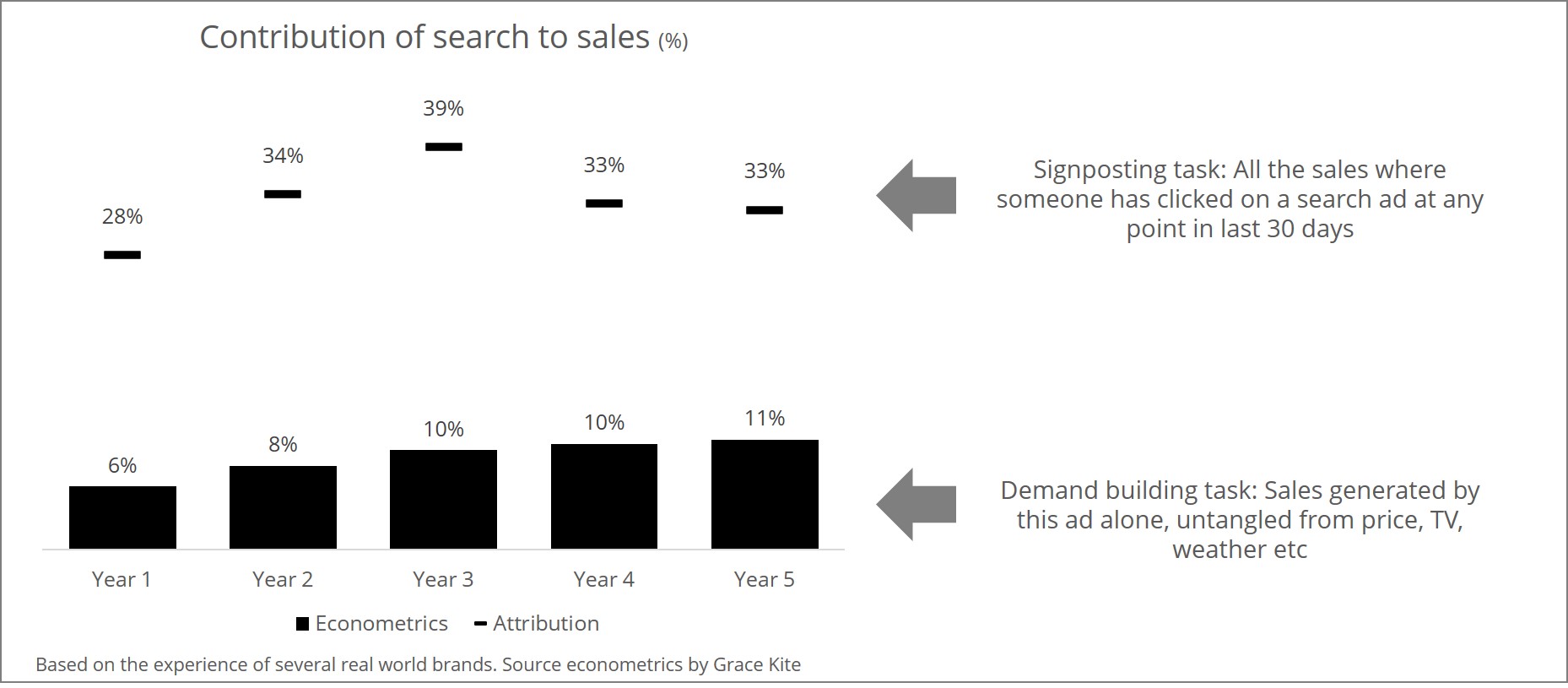 In the chart, the proportion of total sales driven by search ads is around three times bigger in Google’s attribution tool than it is in our econometric modelling. The reason is that in two thirds of customer journeys that involve a search click, the ad didn’t actually generate the sale, it acted as a signpost, helping someone who had already made their decision to complete their purchase.
In the chart, the proportion of total sales driven by search ads is around three times bigger in Google’s attribution tool than it is in our econometric modelling. The reason is that in two thirds of customer journeys that involve a search click, the ad didn’t actually generate the sale, it acted as a signpost, helping someone who had already made their decision to complete their purchase.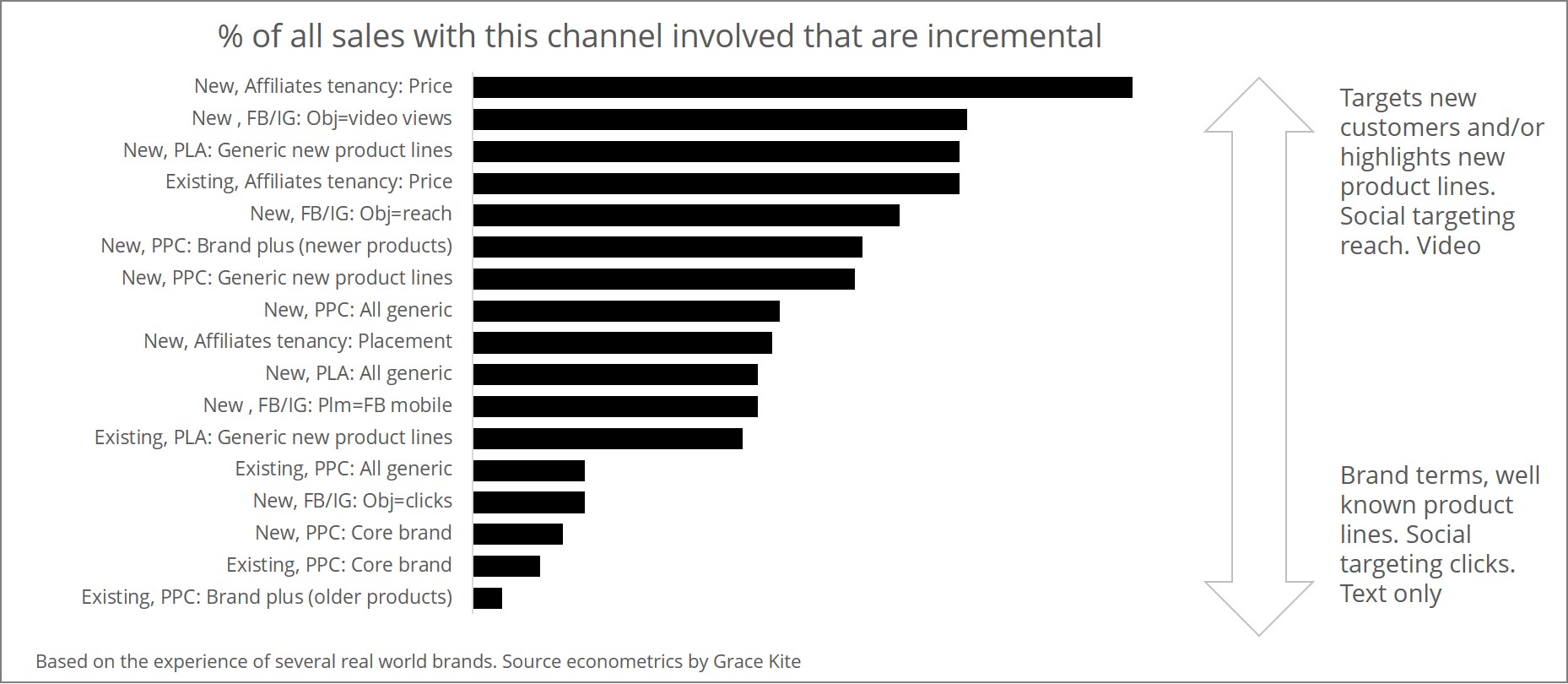 There is still a lot to learn in this area, but the above chart is typical of our limited experience. The online ads that are most often an investment into future sales are those that target new rather than existing customers and reach rather than engagement. They typically have richer creative, particularly video, and they highlight newer or less well-known products.
There is still a lot to learn in this area, but the above chart is typical of our limited experience. The online ads that are most often an investment into future sales are those that target new rather than existing customers and reach rather than engagement. They typically have richer creative, particularly video, and they highlight newer or less well-known products.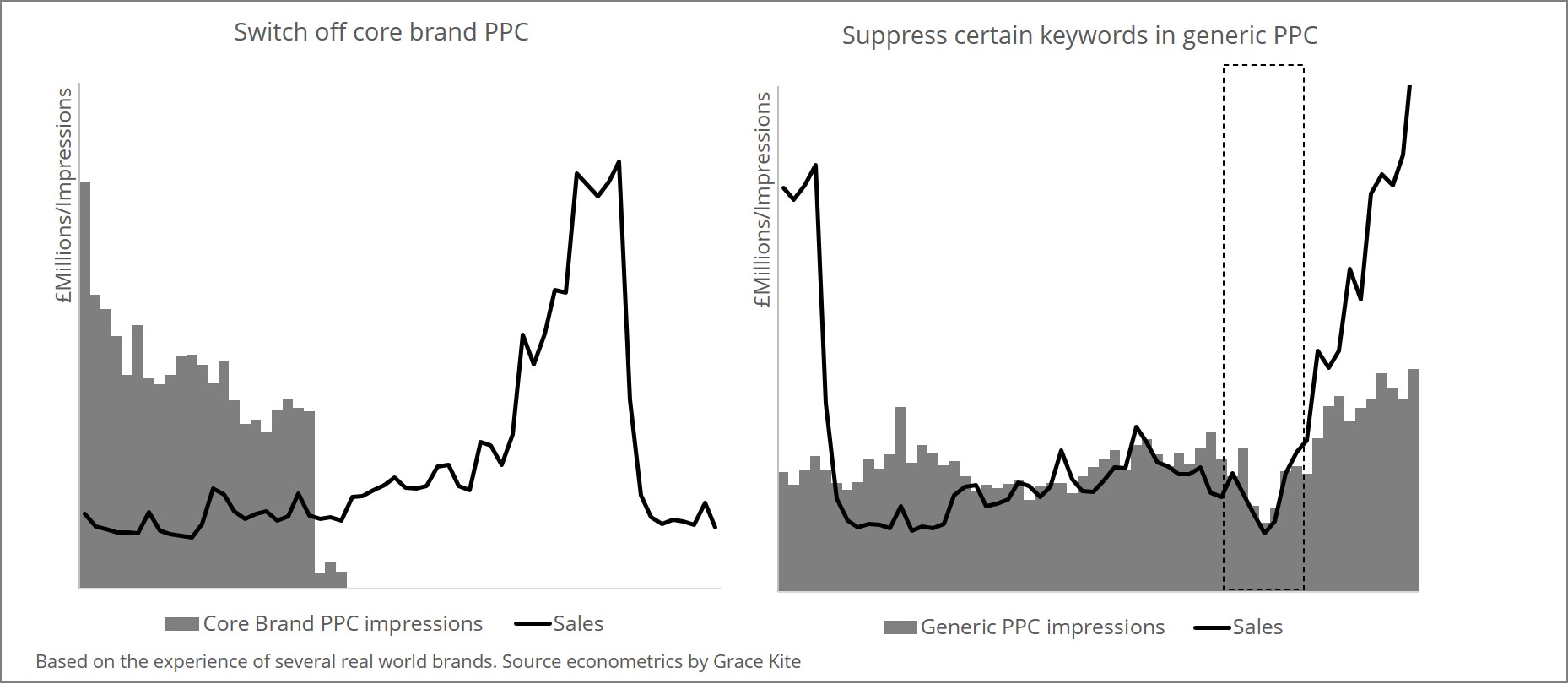 In other cases, the signposting job is revealed to be critical. In the right panel, the switch-off revealed that without a presence in generic search for these keywords, even a customer who had already decided to buy could be diverted and fail to arrive safely.
In other cases, the signposting job is revealed to be critical. In the right panel, the switch-off revealed that without a presence in generic search for these keywords, even a customer who had already decided to buy could be diverted and fail to arrive safely.














